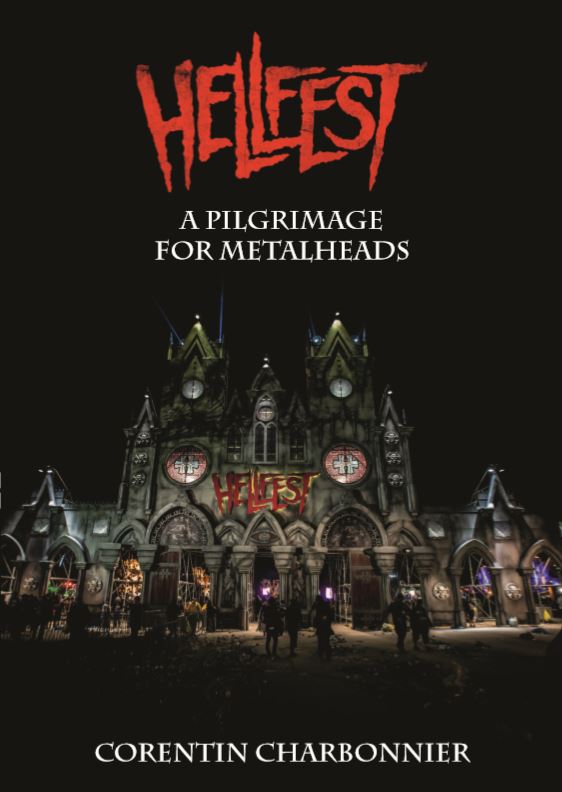 2020, the year the inconceivable happened. No festivals! A rite, a ritual for many and indeed as mentioned in the title a pilgrimage, which is a word that is not without validation as is explored in this book about France’s premier metal music event Hellfest. Personally, I have been twice, once pre the current incarnation when it was known as The Furyfest at Le Mans in 2005 and once at Clisson after the festival had evolved into Hellfest in 2010. Both visits are remembered very fondly, firstly for the excellent cross-section of bands, secondly for the organisation (especially in 2010) and thirdly for the weather; scorchio on both occasions, although a flash flood at the start of 2010 also sticks in my mind. Anyone who has been to Wacken in Germany and Hellfest in France will probably look at them as the top 2 European festivals for extreme music fans and somewhat sadly be well aware that UK efforts pale into pretty much insignificance compared to them. In my opinion the reason that Hellfest excels in particular is due to stages dedicated to certain genres such as The Altar and Temple Stages for predominantly extreme black and death, the Valley for doom and stoner and The Warzone for hardcore and punk. This means you need not even grace the main stages if you are that way inclined, for the more commercial and big end acts.
2020, the year the inconceivable happened. No festivals! A rite, a ritual for many and indeed as mentioned in the title a pilgrimage, which is a word that is not without validation as is explored in this book about France’s premier metal music event Hellfest. Personally, I have been twice, once pre the current incarnation when it was known as The Furyfest at Le Mans in 2005 and once at Clisson after the festival had evolved into Hellfest in 2010. Both visits are remembered very fondly, firstly for the excellent cross-section of bands, secondly for the organisation (especially in 2010) and thirdly for the weather; scorchio on both occasions, although a flash flood at the start of 2010 also sticks in my mind. Anyone who has been to Wacken in Germany and Hellfest in France will probably look at them as the top 2 European festivals for extreme music fans and somewhat sadly be well aware that UK efforts pale into pretty much insignificance compared to them. In my opinion the reason that Hellfest excels in particular is due to stages dedicated to certain genres such as The Altar and Temple Stages for predominantly extreme black and death, the Valley for doom and stoner and The Warzone for hardcore and punk. This means you need not even grace the main stages if you are that way inclined, for the more commercial and big end acts.
Corentin Charbonnier is, like Sam Dunn who you have probably heard of, a metal-head himself and not an outsider looking in. He runs a radio show and is president of The Throne Of Thanatos Association, a journalist and photographer and has also played harp with excellent French pagan metal band Belenos. However, as a metal head yourself (no doubt if you are reading here) this book will be telling you plenty you know already as essentially it was written as a university thesis and looks at the social and anthropological aspects of the festival in detail. That does not mean it is lacking in interest, although the scene setting descriptions of the way of life of people into this music and explaining festivals and their appeal as well as the various genres of music sees the foreword and introduction taking up a big chunk of the book.
Once past this, the festival from origin to development is put into context and this is much more interesting and also illustrated with black and white photos taken by the writer himself (there is also a colour gallery at end of the book). He studied each edition of Hellfest in detail and although far from writing about each band he saw it is more about how the festival has grown where emphasis lies. This is particularly important as far as the local community is concerned and how many business realised that being invaded by thousands of black clad music fans was a good thing and how they could work with them to provide services such as special wine from the region known for its vineyards being just one example. Interviews with organisers and festival goers have been conducted over the years and the writer has included small snippets of these to emphasise his points. We learn about the fact that the festival is a non-profit collective and the major players behind it. Their dedication to the music is looked at and the fact that in the early days they had to go and approach the talent and now the bands, labels and management come to them.
It is obvious how the festival has grown by simple numbers but also here we see the impact of expansion of everything from traders to food concessions making Hellfest in a way a metal city (modelled on Camden High Street) popping up once a year for its dedicated audience. Dedicated they are too, one of the reasons I have not been back since I have not had press accreditation is due to the fact that tickets sell out immediately in advance. For those who have not had the advantage of backstage passes and accreditation this area is also described in detail and I have to say that Hellfest is the best I have ever been looked after in this respect. They even dish out free drinks (Jack Daniels and Jaeger) at certain times of the day. I was also very interested in the information about the Hellfest Cult a group limited to a 1000 who can basically pay extra for certain privileges. Personally, I hate these sort of things and find it a segregation between classes, any privileges should be earned by warrant not by money and others who attend the festival obviously agree. Still it’s considered the norm now and we see it here in the UK too. If a festival is to grow and prosper it is inevitable that a practice like this should exist.
As far as the anthropological side of things is concerned the book puts a lot of persuasive arguments across about the religiosity of metal and festivals, not just in a satanic horn throwing way but also the ritualism that goes with it. This takes in everything from the wearing of band shirts, jewellery, piercings and tattoos to the way we interact in the pit with what to an outsider looks like violent dancing as well as naturally a certain consumption of alcoholic beverages. The iconography of the cathedral like entrance setting as shown on the book’s cover art is one of many examples employed by the festival to actually make the experience of attending as something akin to a religious experience even if many going shun all aspects of organised religion in their general life.
Although academical in construct I found this book a very interesting insight into the workings of a large festival and the culture surrounding it. There might not be any tales of bands exact fees and riders or tales of debauchery and prima donna behaviour such as those which afflicted the last edition of the festival by a group of overrated and overpaid loin-cloth wearers whose name I hardly need to mention. Being written before this and the obvious postponement of the festival in the wake of Coronavirus and the socialistic and economic impact as a result we can only keep our fingers crossed for the survival of Hellfest and other similar events in the future. It would be a great loss for us all if they are unable to weather this storm and we have already read about problems with insurance company ALBINGIA refusing to pay out and being challenged legally by the Hellfest organisation and can only hope for some amicable restitution for them.
Hopefully this book will help in some way and certainly should keep the memory of the festival alive. Support by ordering from the following links.
(Pete Woods)
https://www.hellfestshop.com/gb/home/742-hellfest-pelerinage-livre.html

Leave a Reply